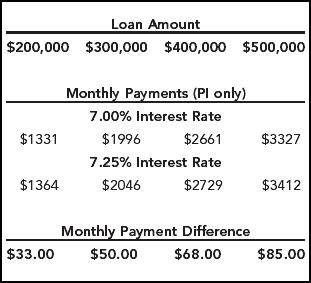Choosing A Mortgage
In recent years, lenders have developed a greater variety of loan programs, mainly because they have found that homebuyers have a variety of different needs. First Time buyers, families "moving up" into larger homes as they need more space, or moving into smaller homes after children have gone on to start their own families; all have different needs. There are so many different individual loan programs available that to compare them all would be impossible. The following provides brief descriptions of the most common categories of mortgage loans.
Fixed Rate Mortgages
Fixed-rate mortgages are the most popular type of mortgage. With this mortgage, the interest rate will remain the same for the entire term of the loan. Typically, the longer the term of the mortgage, the more interest is paid over the life of the loan.
Adjustable-Rate Mortgages
Adjustable rate mortgages all have certain similar features. They have an adjustment period, an index, a margin, and a rate cap. The adjustment period is simply how often the rate changes. Some change monthly, some change every six months, and some only adjust once a year. An Adjustable-rate mortgage (ARM) is a mortgage in which the interest changes periodically according to corresponding fluctuations in an index. All ARMs are tied to indexes. Indexes are simply an easily monitored interest rate that moves up and down over time. Adjustable rate mortgages vary and are tied to different indexes.
Conventional
This is a "traditional" mortgage, not directly insured by the Federal Government. Most conventional loans under $300,700 are administered through Fannie Mae or Freddie Mac (private corporations but regulated by the government). Loans greater than this amount are called "jumbo loans" and are funded by the private investment market.
FHA
These loans are insured by (but not funded by) the Federal Housing Administration (FHA) a division of the U.S. Department of Housing and Urban Development (HUD), and designed for, in general, low- to middle-income borrowers and many first time buyers. There are, however, limits to the maximum loan amount which will vary from county to county. FHA loans have somewhat more relaxed qualifying standards and ratios than conventional loans and have the availability of both 15 and 30 year fixed as well as 1 year adjustable mortgages.
VA
For those qualified by military service, the Veteran’s Administration (VA) insures (but does not fund) 15 and 30 year fixed as well as 1 year adjustable mortgages with lower down payment requirements and somewhat more lenient qualifying ratios.
No/Low Down Payment Mortgages
Sometimes having enough funds for the down payment and closing costs as required by a basic fixed-rate mortgage is not achievable. There is an array of no and low down payment mortgages. These types of loans are designed for homebuyers' varying needs and take into account the many other factors that qualify the financial condition of the borrower. Some loans are designed for buyers with good credit histories, some offer more flexible qualifying requirements and may be helpful for limited incomes, and others balance a low down payment with a higher interest rate.
Negative Amortization
Some adjustable rate mortgages allow the interest rate to fluctuate independently of a required minimum payment. If a borrower makes the minimum payment it may not cover all of the interest that would normally be due at the current interest rate. In essence, the borrower is deferring the interest payment, which is why this plan is called "deferred interest." The deferred interest is added to the balance of the loan and the loan balance grows larger instead of smaller, which is called negative amortization.
Hybrid Mortgage
Mortgage hybrids are a cross between a fixed rate and an adjustable-rate mortgage. They generally have fixed rates for the first three, five, seven or ten years and then they convert to adjustable-rate mortgages (ARMs) for the remainder of the loan term. With hybrid loans the fixed rate is established up front. Once the fixed-rate portion of the loan ends, the mortgage then behaves like an ARM with rate changes and monthly payments moving up and down each year as interest levels change. The attractiveness of these types of loans is that a borrower can sometimes find a 5/1 ARM rate at up to a full percentage point below a comparable fixed rate loan, and for several years the homeowner can benefit from a lower rate. Generally, the shorter the fixed-rate period, the better the up-front discount, the longer the fixed-rate period, the smaller the discount when compared to 30-year financing.
Loan Terms: 15, 20 or 30 Years
As the term of the loan (period over which the loan is paid) decreases, so does the amount of total interest paid. It is a good exercise to make a comparison between a 15 year term monthly payment and a 30 year term monthly payment. The monthly payment difference is often smaller than anticipated. The savings over the term of the loan, however, can be substantial. For example, comparing a 15 year term to a 30 year term, $100,000 mortgage at an 8.5% fixed rate yields the following:

If you cannot qualify for a shorter term loan, try to add at least the amount of 1 additional payment per year—this will take nearly 10 years off a 30 year loan.
Points or No Points
A large component of your mortgage decision has to do with one of the first charges associated with the loan. This is the "points" attached to the mortgage. A point is equal to 1% of the loan amount, and is paid to the lender or the mortgage broker at closing. Each loan product and buyer situation is different. You will need to understand your options and make the best decision based on your situation.
Rates go up as points go down. Here are some examples of monthly payments (principal and interest only):

Courtesy of Sonata Realty
